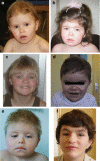Genomic and clinical characteristics of six patients with partially overlapping interstitial deletions at 10p12p11
- PMID: 21522184
- PMCID: PMC3179368
- DOI: 10.1038/ejhg.2011.71
Genomic and clinical characteristics of six patients with partially overlapping interstitial deletions at 10p12p11
Abstract
With the clinical implementation of genomic microarrays, the detection of cryptic unbalanced rearrangements in patients with syndromic developmental delay has improved considerably. Here we report the molecular karyotyping and phenotypic description of six new unrelated patients with partially overlapping microdeletions at 10p12.31p11.21 ranging from 1.0 to 10.6 Mb. The smallest region of overlap is 306 kb, which includes WAC gene, known to be associated with microtubule function and to have a role in cell division. Another patient has previously been described with a 10 Mb deletion, partially overlapping with our six patients. All seven patients have developmental delay and a majority of the patients have abnormal behaviour and dysmorphic features, including bulbous nasal tip, deep set eyes, synophrys/thick eyebrows and full cheeks, whereas other features varied. All patients also displayed various visual impairments and six out of seven patients had cardiac malformations. Taken together with the previously reported patient, our study suggests that the detected deletions may represent a new contiguous gene syndrome caused by dosage-sensitive genes that predispose to developmental delay.
Figures


Similar articles
-
Interstitial 10p11.23-p12.1 microdeletions associated with developmental delay, craniofacial abnormalities, and cryptorchidism.Am J Med Genet A. 2014 Oct;164A(10):2623-6. doi: 10.1002/ajmg.a.36627. Epub 2014 Jul 29. Am J Med Genet A. 2014. PMID: 25073539
-
WAC loss-of-function mutations cause a recognisable syndrome characterised by dysmorphic features, developmental delay and hypotonia and recapitulate 10p11.23 microdeletion syndrome.J Med Genet. 2015 Nov;52(11):754-61. doi: 10.1136/jmedgenet-2015-103069. Epub 2015 Aug 11. J Med Genet. 2015. PMID: 26264232
-
Array-CGH in a series of 30 patients with mental retardation, dysmorphic features, and congenital malformations detected an interstitial 1p22.2-p31.1 deletion in a patient with features overlapping the Goldenhar syndrome.Am J Med Genet A. 2008 Aug 15;146A(16):2109-15. doi: 10.1002/ajmg.a.32447. Am J Med Genet A. 2008. PMID: 18629884
-
An additional case of the recurrent 15q24.1 microdeletion syndrome and review of the literature.Twin Res Hum Genet. 2011 Aug;14(4):333-9. doi: 10.1375/twin.14.4.333. Twin Res Hum Genet. 2011. PMID: 21787116 Review.
-
Chromosome 15q24 microdeletion syndrome.Orphanet J Rare Dis. 2012 Jan 4;7:2. doi: 10.1186/1750-1172-7-2. Orphanet J Rare Dis. 2012. PMID: 22216833 Free PMC article. Review.
Cited by
-
Integrative analysis of genomic variants reveals new associations of candidate haploinsufficient genes with congenital heart disease.PLoS Genet. 2021 Jul 29;17(7):e1009679. doi: 10.1371/journal.pgen.1009679. eCollection 2021 Jul. PLoS Genet. 2021. PMID: 34324492 Free PMC article.
-
An Unclassified Deletion Involving the Proximal Short Arm of Chromosome 10: A New Syndrome?Genes (Basel). 2024 May 21;15(6):650. doi: 10.3390/genes15060650. Genes (Basel). 2024. PMID: 38927586 Free PMC article.
-
De novo loss-of-function mutations in WAC cause a recognizable intellectual disability syndrome and learning deficits in Drosophila.Eur J Hum Genet. 2016 Aug;24(8):1145-53. doi: 10.1038/ejhg.2015.282. Epub 2016 Jan 13. Eur J Hum Genet. 2016. PMID: 26757981 Free PMC article.
-
Phenotypic comparison of patients affected with DeSanto-Shinawi syndrome: Point mutations in WAC gene versus a 10p12.1 microdeletion including WAC.Mol Genet Genomic Med. 2022 May;10(5):e1910. doi: 10.1002/mgg3.1910. Epub 2022 Mar 10. Mol Genet Genomic Med. 2022. PMID: 35266333 Free PMC article.
-
Rapid progression of aortic stenosis in a 3-month-old infant with bicuspid aortic valve and DeSanto-Shinawi syndrome.Ann Pediatr Cardiol. 2021 Apr-Jun;14(2):208-210. doi: 10.4103/apc.APC_20_20. Epub 2021 Mar 26. Ann Pediatr Cardiol. 2021. PMID: 34103862 Free PMC article.
References
-
- Stankiewicz P, Lupski JR. Structural variation in the human genome and its role in disease. Annu Rev Med. 2010;61:437–455. - PubMed
-
- Van Buggenhout G, Van Ravenswaaij-Arts C, Mc Maas N, et al. The del(2)(q32.2q33) deletion syndrome defined by clinical and molecular characterization of four patients. Eur J Med Genet. 2005;48:276–289. - PubMed
-
- Shahdadpuri R, de Vries B, Pfundt R, de Leeuw N, Reardon W. Pseudoarthrosis of the clavicle and copper beaten skull associated with chromosome 10p11.21p12.1 microdeletion. Am J Med Genet A. 2008;146A:233–237. - PubMed
Publication types
MeSH terms
Grants and funding
LinkOut - more resources
Full Text Sources
Medical
Miscellaneous

